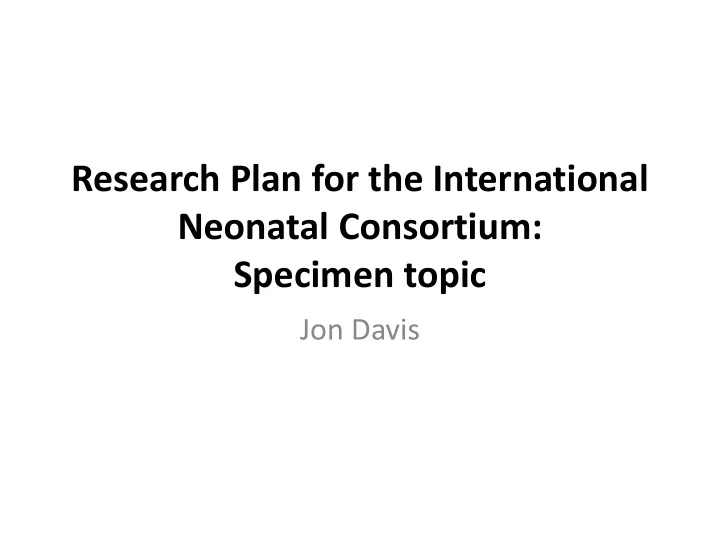

Research Plan for the International Neonatal Consortium: Specimen topic Jon Davis
• The International Neonatal Consortium (INC) will undertake multiple projects to develop effective methods for evaluating the safety and efficacy of therapies in the neonatal population. • At the launch of the consortium, members will discuss and finalize a list of priority projects. • The mission of the consortium is to develop practical tools to increase successful clinical trials in neonates and advance therapeutic options for this population.
• Consortium efforts will focus on conditions commonly encountered in Neonatal Intensive Care Units (NICUs); nonetheless, many of the standardized methods and tools developed through the consortium could be applied to additional therapeutic areas.
The overarching goal of this project is to qualify a biomarker (e.g. • echocardiogram) or composite biomarker (e.g. echocardiogram and serum and/or urine measurement of a compound indicative of right ventricular (RV) strain or pulmonary vascular remodeling) or clinical outcome assessment (COA) instrument for use as a drug development tool in clinical trials for neonates with PH. The Context of Use (COU) could include a prognostic, predictive, • and/or pharmacodynamic biomarker for pulmonary hypertension (as defined by CDER in the 2014 Guidance for Industry and FDA Staff: Qualification Process for Drug Development Tools) 1 . Developing and applying a biomarker/clinical outcome assessment • instrument for PH will be achieved through four interrelated, temporally overlapping specific aims
• Create a neonatal database of aggregated, standardized clinical data from treatment and standard-of-care arms for analysis in support of regulatory submissions. Establish a separate database, which would contain the standard-of-care/placebo arms of the neonatal clinical trials, as a resource that would be publicly available to qualified researchers.
• Create scientific consensus on the optimal measure(s) for a biomarker/clinical outcome measure of PH. Advance a clinically meaningful endpoint for regulatory qualification/endorsement by the FDA, EMA and Health Canada.
• Draft guidance for the conduct of intervention trials in neonates with pulmonary hypertension
Population and biomarkers
• Develop a Master Protocol for conducting clinical trials in neonates with pulmonary hypertension • It is essential that clinical trials designed to evaluate therapeutic intervention in preterm neonates with PH are carefully designed using a “Team Science” approach. This should include neonatologists, pediatric pharmacologists, pediatric cardiologists, epidemiologists, pediatric ethicists and biostatisticians. Studies must include populations at highest risk for developing PH as defined above, which allows the investigators to reduce the number of infants enrolled.
A Master Protocol is needed because: 1. Every aspect of the clinical trial is rigorously standardized • 2. There are several treatment groups (e.g. sildenafil, iNO, inhaled • prostacyclin) and only one control group 3. There is a single database that contains all the complete clinical trial • data. All participants have access to data on their drug as well as comparable agents (in the same or different class of drugs) being developed by competitors. A company benefits by seeing results from the other drug classes and may alter their development programs accordingly. 4. The consortium will serve as the neutral holder of the database, which • would allow the consortium access to other biomarker/COA data collected during the course of the trial that would help the consortium to qualify biomarkers/COAs. 5. Data will be of value to both the academic and pharmaceutical • communities 6. Infants that are not benefitting from one treatment can be switched to • another much earlier than would normally occur.
Recommend
More recommend